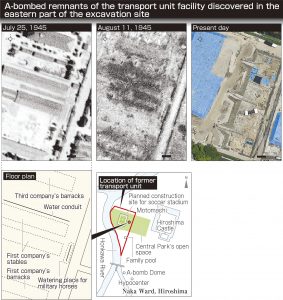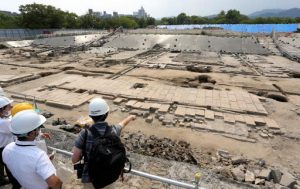Striving to fill voids in Hiroshima, evidence of victims remains 76 years after atomic bombing—Positional clarification shows exhumed stables belong to unit’s first company
Jul. 13, 2021
Stone pavement exposed to thermal rays and blast
by Kyosuke Mizukawa, Staff Writer
On July 12, a comparison of aerial photographs taken by the U.S. military before and after the atomic bombing was used to describe the situation at the time of the atomic bombing and details of each of the facilities excavated from among the remnants of the former Japanese Army’s transport unit known as the Chugoku District transport soldier recruitment unit (“Shichotai” in Japanese). The artifacts were discovered in the open space of Hiroshima’s Central Park in the city’s Naka Ward, the location of a new planned soccer stadium. Four horse stables, which were burned to the ground in the atomic bombing but whose foundations remain, were found to belong to the unit’s first company. Also confirmed was the existence of a watering place for military horses where stone pavement was discovered, as well as the fact that the stone pavement had been directly exposed to the thermal rays, blast, and radiation from the atomic bombing.
With the assistance of Yoshihiko Takesaki, 63, a specialist in geography and former assistant at Hiroshima University’s Research Institute for Radiation Biology and Medicine, the Chugoku Shimbun compared three aerial photos by superimposing them on top of each other. Two photos submitted by the U.S. military were taken on July 25 and August 11, 1945, which was only a few days after the atomic bombing, while the present-day photo was taken by the Chugoku Shimbun on June 10, 2021. Names of the structures were taken from a layout drawing described in the book titled Hiroshima Shicho Heitai Shi (History of Hiroshima Transport Soldiers, in English), which was published in 1973.
As a result, it was found that the two stables unearthed in the east part of the excavation site belonged to the unit’s first company, the mission of which was to transport military supplies by horse. The photo taken soon after the atomic bombing shows that both stables were completely destroyed by fire and their ruins appear to be black. In the present-day photo, some parts of the stable ruins appear blackened.
The exact location of the watering place for horses, from which an approximately 20-meter-long stone pavement was excavated, was not described in the book Hiroshima Shicho Heitai Shi (History of Hiroshima Transport Soldiers, in English), but that spot was confirmed in the photos taken before and after the atomic bombing. At the center of the stone pavement, which appears white in the photos, a black line assumed to demarcate the position of a water tank set on the stone pavement can be seen.
The barracks, whose foundations were excavated on the north side of the first company’s stables, were found to belong to the third company, which served as a mobilized unit. The remains of water conduits were discovered to have been located between the first and third companies. Looking at the photo taken before the atomic bombing, the same kind of black line can be seen at nearly the same location.
The Hiroshima City government usually considers clear evidence of the atomic bombing as one of the factors it utilizes for making a decision on whether or not to preserve and utilize remnants and artifacts. With regard to the findings from the excavation site, a representative of the city’s Cultural Promotion Division said, “The Hiroshima City Cultural Foundation (the organization to which Hiroshima City commissioned the excavation survey) will conduct the necessary confirmation work.”
The barracks of the transport unit were spread out over an area stretching to within one kilometer of the hypocenter. Hiroshima citizens’ groups and A-bomb survivors’ groups are calling for preservation of at least a portion of the remnants. “It is important to convey the fact that Hiroshima had military facilities and that they were destroyed in the atomic bombing,” contends the groups. The city has already registered 86 existing structures located within five kilometers of the hypocenter at the time of the atomic bombing as “A-bombed buildings,” regardless of whether or not there is clear evidence of the atomic bombing. There are nine such buildings within one kilometer of the hypocenter.
(Originally published on July 13, 2021)









